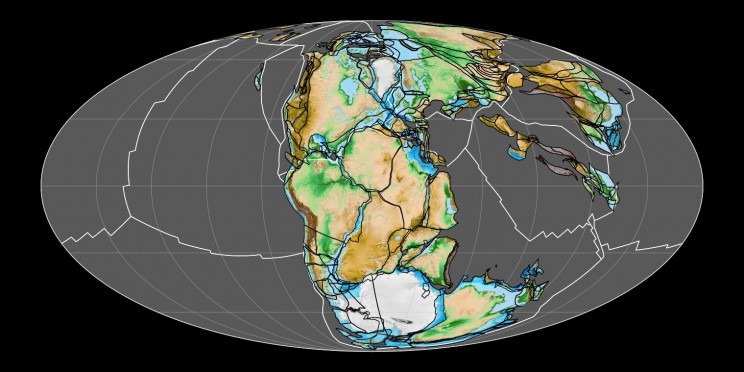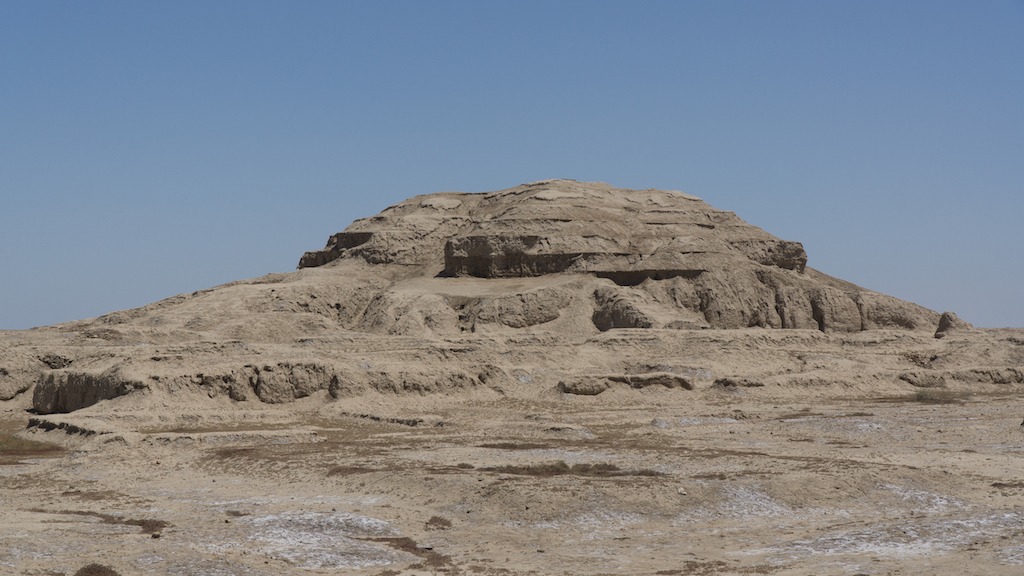Pangaea is the supercontinent that was one large land mass and in 200 million years we will have yet another supercontinent. The following is from interestingengineering.com and written by Christopher McFadden. This will be a two part story that is very interesting how Geologists figured this out by looking at rocks.
"Anyone in for a trip back in time to visit the supercontinent Pangaea?
You are probably more than familiar with the map of the world today. The position and extent of the continents may even have been a fundamental driving force for the development of our species, cultures, and history. Author Jared Diamond argued this in his controversial 1997 work Guns, Germs, and Steel.
But, in the grander scheme of the universe and of Earth's long history, the current arrangement of the continents is but a snapshot in time of an ever-evolving and ever-changing surface. Through the power of a process known as plate tectonics, the crust of the Earth is constantly in flux, with the continents wandering around it over time.
At certain times in Earth's history, this has led to all of the world's continents coalescing in a giant car crash millions of years in the making. These giant continental pileups are called supercontinents, and they are something of an occupational hazard for the landmasses of the globe.
In fact, some researchers argue that there is a 'supercontinent cycle', where, over the course of hundreds of millions of years the tectonic plates drift apart and then back together again to form supercontinents.
Let's take a closer look at the latest, and most famous, of these supercontinents - the mighty Pangaea.
What was Pangaea?
Pangaea, also spelled Pangea, was a massive supercontinent that incorporated almost all the landmasses on Earth in one place. Roughly resembling a large "Pacman" or letter "C", the supercontinent would have stretched from each pole of the Earth in one continuous landmass.
Its name is derived from the Greek pangaia, meaning, roughly, “all the Earth.”
This landmass would last for around 150 million years before beginning to spectacularly break apart about 200 million years ago during the Early Jurassic Epoch (about 201 million to 174 million years ago). Throughout the Mesozoic (Triassic to Cretaceous eras), Pangaea split into two major continents called Laurasia (in the North) and Gondwanaland (in the South) with the embryonic Atlantic Ocean separating them.
These continents would further subdivide over time to eventually form the map of the world we all know so well today.
This process would continue unabated until the modern-day with the formation of the modern continents and the Atlantic and Indian oceans as a consequence of this event.
Pangea’s existence was first proposed in 1912 by German meteorologist Alfred Wegener as a part of his theory of continental drift, a now widely accepted geological process.
What evidence do we have that Pangaea actually existed?
As the astronaut Neil Armstrong once said, "geologists have a saying - rock remembers". The main evidence we have for any past events, especially millions of years ago, is from studying rock formations and their contents.
Fossils, chemical analyses, mineral content, etc, all tell us a tale of what was happening when a piece of rock was originally formed. By careful analysis of rock formations locally and around the world, geologists are able to paint a picture of past conditions on the Earth.
Part of this process in the field of paleogeography, or the study of ancient geography, tries to piece together the physical features of the Earth in the distant past, including landmasses like supercontinents.
Much like a giant jigsaw puzzle, it is possible to find rock formations that have the exact same composition but are located in different parts of the world. So, for example, there are some types of igneous rock in Scotland that cannot be found anywhere else except in some parts of Greenland and the United States.
This indicates to geologists that Scotland (and not the rest of the UK), must have once been connected to these parts of Greenland and the United States in the past. In fact, it is now believed that 500 million years ago Scotland was separated from England and Wales by the ancient Lapetus Ocean. In fact, it is thought that the Scottish Highlands, the Appalachians, the Ouachita Mountains, and the Little Atlas of Morocco were once part of the same mountain range, the Central Pangean Mountains.
Scotland eventually separated from Greenland and Noth America about 60 million years ago when the North Atlantic began to form.
Many other examples exist, including the rocks that made up a series of enormous Gondwana mountains, which can now be found in both Brazil and northern Africa and date to the same period.
These are but two bits of evidence to show that the modern setup of continents is not the way it has always been. By mapping out similar formations like this, geologists can begin to build up a picture of what the world must have looked like.
There are other methods too that help corroborate this kind of reconstruction. Scientists can use the radioactive decay rate of different elements to get fairly precise estimates of the date of rocks hundreds of millions of years old.
Another key piece of evidence, though admittedly directly related to the above, is the study of fossils.
This is a powerful tool in geology and has been a vital tool for piecing together the ancient supercontinents.
Since we can be fairly sure that members of the same species probably lived fairly close together (at least to begin with) they can indicate that the places they are found were probably geographically close at one point.
Today, we can find various fossils of the same species on completely different continents. For example, fossils of the same species (Lystrosaurus) of small, land-based reptiles have been found in Antarctica, India, and South Africa. As these creatures were land-dwellers, we can be fairly certain that they would not have been able to travel across vast distances of water like the Atlantic Ocean.
This would indicate that when these creatures existed, those parts of Antarctica, India, and South Africa, must have been connected in some way in the past! There are many other, similar, examples in the fossil record.
But, if that still isn't enough corroborating evidence for you, geologists can also employ the power of physics. A specialist field called paleomagnetism has also been employed to add further weight to our confidence in the Pangaea hypothesis.
Some rocks, usually igneous (made from lava or magma) contain magnetic-sensitive minerals like those that are iron-titanium oxide rich, which can be studied to discover their relative position on Earth when they formed. Since these minerals will align within the Earth's magnetic field when the rock forms, they offer another interesting type of supporting evidence for Pangaea.
By looking at the orientation of these grains in the rock, and comparing them to the known location of Earth’s magnetic pole at the time when they were formed, scientists can get an idea of where the rocks were formed. You can liken this to looking at tiny compasses that have been locked in position.
When geologists study ancient rocks, like basalt, they can effectively rotate the land area around to see what orientation they would have been in the past. If this is done en masse and compared to other rocks of similar age, we get another powerful piece of evidence for reconstructing the ancient supercontinent.
5 prodigious Pangaea facts
Looking for some more information on Pangaea? Then you've come to the right place.
Read on to find some more fascinating facts about Pangaea and the potential future of the planet's continents.
1. Pangaea may be reborn in the future
As we've already discussed, at the end of the Permian Period, all the major landmasses of the world were joined together into what geologists call Pangaea. During the Triassic Period (about 200 million years ago) this supercontinent began to break apart.
We'll discuss some of the current theories about why this happened in a moment, but the process (if watched from space in fast forward) would resemble a slow-motion explosion. The process starts slowly at first, with the formation of Laurasia and Gondwanaland as continents drifted apart, but things appear to rapidly accelerate from the Jurassic Period (1bout 150 million years ago) onwards.
By the end of the Cretaceous (about 65 million years ago), the basic building blocks of our modern continents are, more or less, recognizable and resemble massive shards of the shattered former supercontinent. Obviously, the "explosion" is happening on a single spherical plane, so the pieces are very limited in where they can travel in "space".
The chunks of the former Pangaea continue to spread across the surface of the Earth into the modern-day with India impacting the "underside" of Asia, the African chunk hitting Southern Europe, and the Americas conjoining. Incredibly, this process is nowhere near finished, and plate tectonics will change the features of our planet's surface well into the future.
It is notoriously difficult to predict what the future shape of Earth's landmasses may look like, but it appears another supercontinent is on the cards. Notionally called Pangaea Proxima, it is believed this new supercontinent will form roughly 200 million years in the future.
2. Pangaea would have been a land of extremes
Pangaea was so massive, that the climate would have varied enormously across it. The interior of the continent, for example, would likely have received very little rain and was probably incredibly arid and hot.
It is also important to note, that average temperatures at the time of Pangaewere incredibly high compared to those today. Scientists believe that temperatures were about 38 degrees Fahrenheit (20 degrees Celsius) hotter in the summer, and atmospheric carbon dioxide was five to 20 times greater than today.
Some modern studies using climate models have also shown that the interior of Pangaea was also probably very seasonal. A 2016 study, for example, used geological data from the Moradi Formation in Northern Niger.
The rocks here consist of layered fossilized soils (called, funnily enough, paleosols), to reconstruct the ecosystem and climate during the time period when Pangaea existed. They found that this region would have resembled the modern-day Namib Desert in Africa or Lake Eyre Basin in Australia.
Today, the climate in these regions is generally arid with short, recurring wet periods that occasionally included catastrophic flash floods.
As we know today, from the locations of fossil fuels initially formed in this period, other parts of the supercontinent would have been incredibly lush, dense, jungle-like areas. Those parts of Pangaea that now form the coal-rich areas of the United States and Europe were probably located on or near the equator and would have resembled the modern-day Amazon (except with very different plants and creatures).
The coastal regions wouldn't be too dissimilar to today with the exception of course, of now long-extinct fauna and flora.
3. Pangaea might have contributed to one of the world's worst mass extinctions
At the end of the Permian Period (circa 250 million years ago), one of the worst, if not the worst, mass extinction events devastated life on Earth. Estimates vary, but somewhere in the region of 70%-90% of all life was wiped off the face of the Earth.
The loss of life was so immense, that the event is generally known as "the Great Dying" and it formed the boundary between the Permian and Triassic periods.
Prior to the extinction event, the predominant form of life on land and in the sea were large reptiles and synapsids (mammal-like reptiles and our ancestors).
Geologists and paleontologists can't be entirely sure why this happened. Recent papers suggest volcanic activity led to the release of an immense amount of greenhouse gases, leading to global warming and ocean acidification on a vast scale.
However it occurred, the event changed life on our planet forever. It also helped paved the way for the rise of the dinosaurs and their descendants. The massed volcanism would have also driven the breakup of Pangaea.
We know this because in the area we now call Siberia, enormous flood basalts have been found from that time. These effusions released huge amounts of CO2 and other gasses into the atmosphere.
Other theories include a large asteroid impact or a nearby supernova exposure. Or, it could have been a combination of several factors.
Such was the change to the global climate that nowhere on Earth appears to have been a safe haven. Many lineages were destroyed never to return including the mighty sea scorpions, trilobites, and many more.
4. Pangaea is the most recent supercontinent we know about
As far as we know, Pangaea is the most recent supercontinent that geologists have been able to piece together. There are thought to have been many others before Pangaea, but geologists are less confident about their reconstructions of these.
This is based, in part, on a very rough rule of thumb of supercontinent formation and breakup over cycles of around 400-500 million years.
Pangaea itself took hundreds of millions of years to come together, and was, itself, the amalgamation of other larger continents. The process of building the massive rock Pacman started around 480 million years ago when a large continent called Laurentia (which includes present-day North America) merged with several other micro-continents to form Euramerica.
We are confident you can work out what part of the modern world that includes.
Euramerica, in turn, then eventually collided with Gondwana, another supercontinent that included Africa, Australia, South America, and the Indian subcontinent. Pangaea lasted for around a hundred million years, before completely breaking up in the Jurassic.
5. You can still see the pieces of the Pangaea puzzle today
"
To be continued tomorrow!
Note there was was a lot of CO2 in our atmosphere way before humans was even a concept. So those who said that CO2 emissions is only driven by humans are lying to you. The heat was a lot hotter than it was today as noted by scientists believe that temperatures were about 38 degrees Fahrenheit (20 degrees Celsius) hotter in the summer, and atmospheric carbon dioxide was five to 20 times greater than today. So they are Bullshitting you that the Earth will end in 10 years or less. Rocks do not tell lies or have political agendas. The remaining if this article will be tomorrow.
Reference: https://interestingengineering.com/pangaea-earth-ancient-supercontinent-extinction
I have lost a lot of faith with the Medical Community and the Governments over the last several years, but there are a few good things that can raise above the corruption and the pushing of drugs a new approach to heal people. The following is from www.gaia.com and written by Hunter Parsons that does not involve any drug or pushing an ineffective so called vaccine that the drug company is not held accountable in any way but they use sound! The use of sound can regrow bone tissue! Here is the story:
"The future of regenerative medicine could be found within sound healing by regrowing bone cells with sound waves.
The use of sound as a healing modality has an ancient tradition all over the world. The ancient Greeks used sound to cure mental disorders; Australian Aborigines reportedly use the didgeridoo to heal; and Tibetan or Himalayan singing bowls were, and still are, used for spiritual healing ceremonies.
Recently, a study showed an hour-long sound bowl meditation reduced anger, fatigue, anxiety, and ...
Not a fan of a Defense Agency studying Anti-Gravity and other Exotic Tech, but if the commercial world and make this technology cheap that will change our world yet again. The following is about three minute read and from www.gaia.com. The below was written by Hunter Parsons:
"Wormholes, invisibility cloaks, and anti-gravity — it’s not science fiction, it’s just some of the exotic things the U.S. government has been researching.
A massive document dump by the Defense Intelligence Agency shows some of the wild research projects the United States government was, at least, funding through the Advanced Aerospace Threat Identification Program known as AATIP.
And another lesser-known entity called the Advanced Aerospace Weapons System Application Program or AAWSAP
The Defense Intelligence Agency has recently released a large number of documents to different news outlets and individuals who have filed Freedom of Information Act requests.
Of particular interest are some 1,600 pages released to Vice News, which ...
As our technology gets better we are discovering more about the history of mankind and pushing the timeline back further and further. The following article is from www.gaia.com and written by Michael Chary that discusses this new find that changes the historical timeline:
"Over the past decade, there have been a number of archeological revelations pushing back the timeline of human evolution and our ancient ancestors’ various diasporas. Initially, these discoveries elicit some resistance as archeologists bemoan the daunting prospect of rewriting the history books, though once enough evidence is presented to established institutions, a new chronology becomes accepted.
But this really only pertains to the era of human development that predates civilization — the epochs of our past in which we were merely hunter-gatherers and nomads roaming the savannahs. Try challenging the consensus timeline of human civilization and it’s likely you’ll be met with derision and rigidity.
Conversely, someone of an alternative...
Not sure if you have heard of a show on YouTube called "The Why Files". If not you should check it out it is interesting and has some humor with it on different subjects. Last weeks was on a different theory how the Universe works and how main stream Science is attempting to shut it down like is always seems to do if it goes aguest some special interest. Today it is akin to what happened to those who questioned the Earth was the Center of the Universe that main stream so called Science all believed during the Renaissance period, They called any theory that the Earth was not the Center of the Universe misinformation. Does this sound familiar today? People laughed and mocked people like Leonardo da Vinci, Nicolaus Copernicus, Georg Purbach as crack-pots, conspiracy theorists, nut-jobs and they were suppressed and even imprisoned for their radical thoughts and observations. Again it sounds like today in so many ways. In any event this is a good one to ponder and see even if a bad idea ...
Seemingly chaotic systems like the weather and the financial markets are governed by the laws of chaos theory.
We all have heard about chaos theory, but if you have not or have forgotten what chaos theory is well here you go from interestingengineering.com:
"Chaos theory deals with dynamic systems, which are highly sensitive to initial conditions, making it almost impossible to track the resulting unpredictable behavior. Chaos theory seeks to find patterns in systems that appear random, such as weather, fluid turbulence, and the stock market.
Since the smallest of changes can lead to vastly different outcomes, the long-term behavior of chaotic systems is difficult to predict despite their inherently deterministic nature.
As Edward Lorenz, who first proposed what became commonly known as the Butterfly Effect, eloquently said, "Chaos: When the present determines the future, but the approximate present does not approximately determine the future.""
You may have heard the term about chaos theory as a butterfly flaps its wings in Brazil,...
I for one have lost trust in Medical Doctors due to COVID and reflection that they seem to push pills for everything and untested so called vaccines that is using a unproven technology because the Government and the Medical Boards of the State told them to. There are a very few exceptions. Thus they do not address the key problem just prescribe more and more pills to keep you alive an sick longer for them and Big Phama to profit from you. Will AI do any better? Well that depends on what was used for the training of AI. If it also pushes pills and vaccines without question then you have the same problems noted above. However, if the AI Training includes all possible forms of treatment and they zero in on the right issues for the true problem then there is possibilities they would be way better than most of the current Medical Doctors today.
The following is from an article from interestingengineering.com and written by Paul Ratner:
"A new study looks at how accurately AI can diagnose patients. We interview the researcher, who weighs in on AI's role ...



























